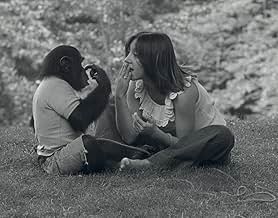Ajouter une intrigue dans votre langueTells the story of a chimpanzee taken from its mother at birth and raised like a human child by a family in a brownstone on the upper West Side in the 1970s.Tells the story of a chimpanzee taken from its mother at birth and raised like a human child by a family in a brownstone on the upper West Side in the 1970s.Tells the story of a chimpanzee taken from its mother at birth and raised like a human child by a family in a brownstone on the upper West Side in the 1970s.
- Réalisation
- Scénario
- Casting principal
- Nomination aux 1 BAFTA Award
- 16 victoires et 30 nominations au total
- Self
- (images d'archives)
- Self
- (images d'archives)
- Self
- (as Dr. James Mahoney)
- Self
- (images d'archives)
Avis à la une
The chimp's name is taken from Noam Chomsky, the famous MIT linguist. Unfortunately, the linguistic side of this story actually is quite minor compared to what really occurred. Columbia professor Herbert Terrace wanted to conduct an experiment on a baby chimp to see if it could be raised like a human baby and learn to communicate with people. He started the project by snatching the baby from its mother at two weeks of age, and then plopping it right into a large, free-spirited family with no scientific or primate-training background. Heck, no one in the family even knows sign language! The film shows how quickly Nim adapts to the pampered lifestyle and is even breast-fed by Stephanie, the mother. Nim is also exposed to smoking pot, drinking alcohol and even has limited success being potty trained. All of this is explained away with "it was the seventies". I was already bouncing between sadness and anger.
Admittedly, I am no scientist. I do know that a true science experiment or project would involve specific records and at least some type of plan ... not to mention the recording of actions, tests and progress. Instead, Professor Terrace shows up periodically for some photo ops and a hug from Nim. Poof! He is gone again. While this is never really explained in the film, one can only assume he was benefiting nicely from a huge grant, not to mention "close" relationships with a couple of his assistants. The other thing left unexplained was how Nim's mother had other babies taken from her in a similar manner. We get no detail on those "experiments".
As Nim gets older, guess what ... he gets bigger and stronger. He is difficult to control and even lashes out periodically at his caregivers, once quite violently. He is bounced from home to home and person to person. He does adapt, but he is just too strong and unpredictable to be part of human society. Finally, he is sold off to an animal rescue farm. That's just great, except initially there are no other chimps. Not a good thing for a social primate.
The whole thing is just painful to watch. I couldn't help but feel sympathy for the chimp and anger at the people ... especially Professor Terrace. His selfish, ill-conceived project negatively impacted the life of a chimp and the safety and well-being of many good-hearted people along the way.
While there was proof that Nim learned approximately 125 signs, the question remains ... did he really understand these words and phrases? Did he instead learn behavior that led to his reward? One of Nim's later day caregivers (Bob Ingersoll) visited him often at the rescue farm until at the age of 26, Nim passed away. The average lifespan of a chimp in the wild is about 45 years. So, it would appear neither the chimp or the people really benefited from Project Nim. It is, however, a well made documentary.
There is a huge amount going on in this documentary as the carers over the years are interviewed with footage from the time. What emerges will probably anger and sadden most viewers. Though I felt that Nim's carers genuinely bonded with him what emerges is a largely a tale of careless cruelty.
Equally interesting and perhaps the root cause of what happens later is the relationships between the humans. Particularly between the project leader Professor Herbert Terrance and the numerous attractive research assistants. There are several references to the power he held and exercised. Overall it has to be said he does not emerge from this film as either likable or particularly competent.
The various approaches of the teachers and carers differ so widely and even though there is much happy footage you have to wonder at the effect this had on Nim. I was left with the feeling that he eventually responded best to the people who recognised him as a chimp but still treated him as a companion within the limits this imposed.
This is a powerful film that should be shown as widely as possible and would probably be good thing to included in school curricular.
The movie is more about a team of people trying to salvage and place an off the track train back on it, when the damage was already done.
Firstly, I do agree with the other reviewers comments on futility, I do not, however, agree entirely with Professor Terrace's view that the project was a failure, though conversely I do think the project failed Nim. To expand on this I would say that the conclusion of Terrace's failure seemed to fit a classic narrow set of parameters by which you compare and judge the outcome solely on an initial and highly specific expectation of what you will achieve. To this end perhaps it failed Professor Terrace's criteria.
I think however opportunities were certainly lost. Nim seemed to interact in so many subtle and fascinating ways during the process of his teaching, and he seemed to teach a great deal to all of the assistants who gave him their care. There seemed to be so little structure from the start with regards to what was to be taught and observed and in which direction the project should be going.
The only constant seemed to be the teaching of signing, at which Nim excelled! From what I could see, regardless of whether he learnt the actions to manipulate his handlers or not, he still learnt the signs. Since it was known that the chimp could not form human speech, how was it to communicate what it had learnt and why it was using the language in this way? I found this point frustrating and dubious and an example of one person with their eye so "firmly on the prize", that they miss the importance of the process.
Importantly, everybody who was involved across the duration of the project was given a chance to clearly state the turn of events. Perspectives on this varied widely, as you would expect, as everybody brought a different set of expectations and sensibilities, but it was a mature approach which I think led to the films balanced handling of Nim's story.
All in all I found it a fascinating cautionary tale. Luckily the balance of academic ego versus humanity that twists through this story left me with hope that indeed something had been learnt from the unique life of this Chimpanzee.
The story starts out well, with the impossibly cute baby chimp brought up as a human. Soon, though, the behaviour of some of the "scientists" looking after Nim begins to grate; some of them are a little too involved with their subject, while others are plain creepy. Later, Nim suffers a huge betrayal, and at this point the documentary takes a downward turn into one of the most depressing ever.
Hardly a heartwarming story then, in that it focuses on misery and despair for the majority of the running time, but nevertheless an important story that serves to highlight man's inhumanity towards the world he inhabits.
Le saviez-vous
- AnecdotesVeteran primate choreographer and actor Peter Elliott actually met and worked with Nim Chimpsky when he was researching chimpanzees for Greystoke, la légende de Tarzan (1984). He also met and worked with another famous signing chimp by the name of Washoe.
- Citations
Herbert Terrace: Wouldn't it be exciting to communicate with a chimp and find out what it was thinking? If they could be taught to articulate what they were thinking about, this would be an incredible expansion of human communication, and possibly give us some insight into how language, in fact, did evolve.
- ConnexionsFeatured in Maltin on Movies: Harry Potter and the Deathly Hallows: Part 2 (2011)
- Bandes originalesCollide
Written by Autumn Rowe
Meilleurs choix
- How long is Project Nim?Alimenté par Alexa
Détails
Box-office
- Montant brut aux États-Unis et au Canada
- 411 184 $US
- Week-end de sortie aux États-Unis et au Canada
- 25 820 $US
- 10 juil. 2011
- Montant brut mondial
- 612 839 $US
- Durée1 heure 33 minutes
- Couleur
- Mixage
Contribuer à cette page




























